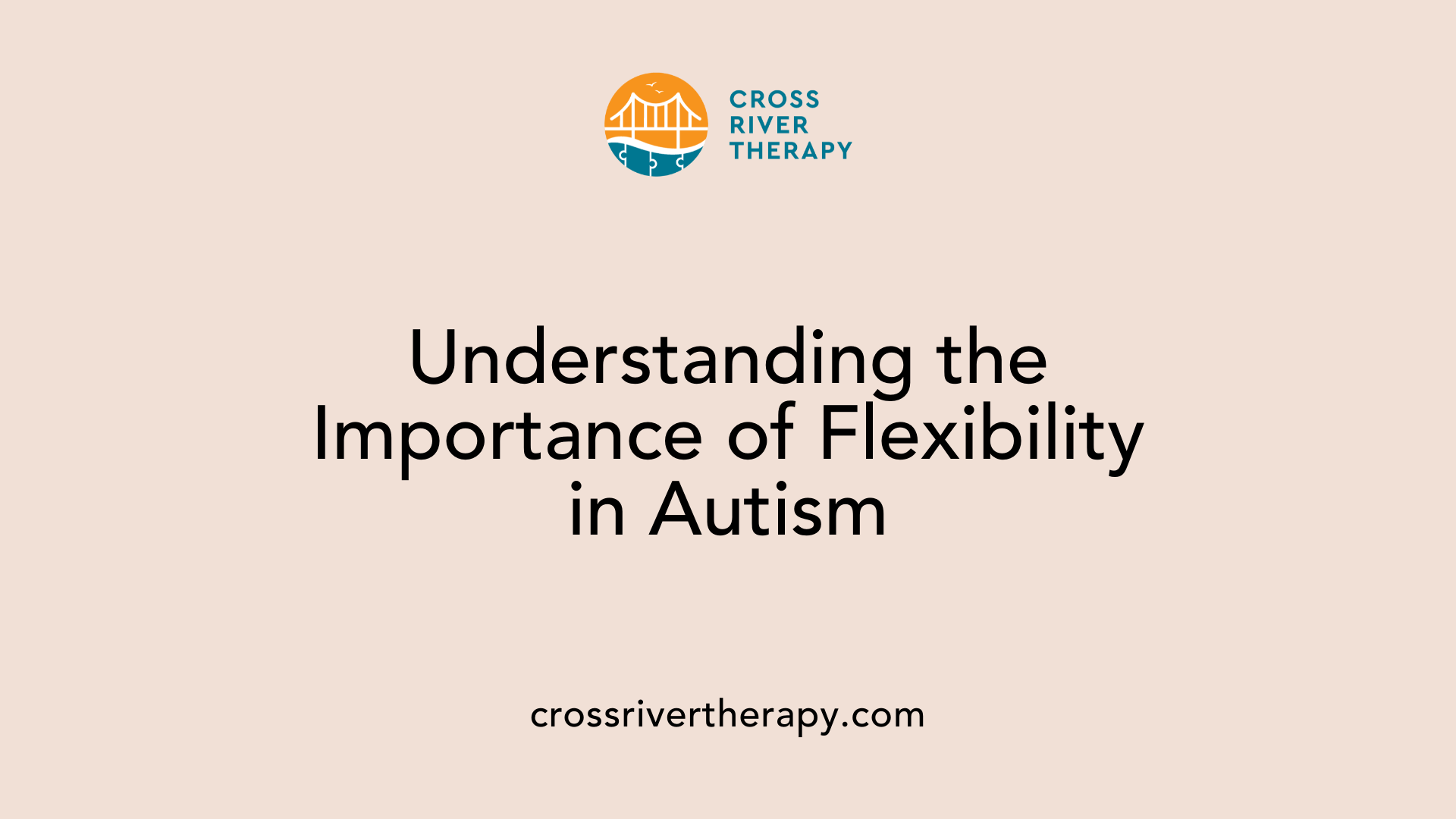The Importance of Flexibility in ABA Therapy for Children with Autism
Unlocking Adaptability: How Flexibility in ABA Therapy Transforms Lives of Autistic Children
Understanding Flexibility in ABA Therapy
For children with autism, mastering flexibility is a crucial life skill. Applied Behavior Analysis (ABA) therapy offers techniques to foster this adaptability, addressing both cognitive and behavioral flexibility. This narrative explores the importance of teaching flexibility in ABA therapy, providing insights and strategies for promoting adaptability in children with autism.
The Role of Flexibility in Autism

What is Flexibility in Autism?
Flexibility, especially in the context of autism, refers to the capability of adjusting thoughts and actions when faced with changing circumstances. This is often categorized into two main types: cognitive flexibility and behavioral flexibility. Cognitive flexibility involves adapting one's thought processes during shifts in tasks or demands, while behavioral flexibility pertains to adjusting actions based on situational changes.
Despite common perceptions that individuals with autism struggle significantly with cognitive flexibility, recent research suggests a more complex picture. For instance, studies utilizing the Wisconsin Card Sorting Task have shown that flexibility is just one of many cognitive processes at play. Factors like attention-deficit/hyperactivity disorder (ADHD) co-occurring with autism can skew the results, indicating that a lack of cognitive flexibility may not always be the primary issue.
Cognitive Flexibility Challenges
Children on the autism spectrum often encounter specific difficulties with cognitive flexibility, which can manifest in social interactions and communication skills. These challenges may arise from ingrained routines and resistance to change, which can lead to heightened anxiety during unexpected disruptions.
Moreover, research shows that intentional training can enhance cognitive flexibility among children with autism. In a study involving play activities over multiple sessions, improvements were observed using tools like the Behavioral Flexibility Rating Scale. Participants demonstrated increased adaptability, highlighting the effectiveness of structured interventions in fostering flexibility.
To summarize, flexibility is vital for children with autism as it allows them to manage changes more effectively in their daily lives. By embracing methods like visual schedules and gradual exposure to new routines, children can learn to navigate their environments with reduced stress.
Impact of Rigidity and Flexibility on Daily Life

How does rigidity and flexibility impact the daily lives of children with autism?
Rigidity and flexibility significantly affect the daily experiences of children with autism, shaping how they cope with various challenges. Many autistic children find comfort in routines, which can help reduce anxiety. However, this reliance on fixed patterns can lead to distress when changes occur, resulting in problematic behaviors and emotional outbursts.
Daily challenges faced by autistic children
Children with autism often struggle with unexpected changes in their routines. This may include:
- Transitioning between activities: Sudden changes can trigger stress and anxiety.
- Handling social situations: Difficulty in adapting to new interactions can hinder socialization.
- Managing family events: Changes in schedule can lead to resistance, affecting family dynamics.
Consequences of behavioral rigidity
Behavioral rigidity can lead to a range of issues:
- Emotional distress: Rigid adherence to routines can cause overwhelming frustration.
- Behavioral problems: Resistance to change can manifest in tantrums or withdrawal.
- Increased anxiety: Challenges managing transitions may heighten overall anxiety levels, impacting everyday living.
Benefits of learning flexibility
Teaching flexibility is essential for enhancing the quality of life for children with autism. Benefits include:
- Improved problem-solving skills: Regular practice with minor changes can enhance cognitive processing.
- Increased adaptability: Children learn to embrace change rather than fear it.
- Greater confidence: Successfully navigating changes boosts self-esteem and encourages exploration.
Research suggests that targeted interventions can yield significant improvements in flexibility, allowing children to better manage disruptions and foster smoother transitions in their lives.
How ABA Therapy Supports Flexibility

How can ABA therapy help children with autism, especially those who are high functioning?
Applied Behavior Analysis (ABA) therapy provides substantial benefits for children with autism, particularly those who are high functioning. One of its primary advantages is the enhancement of crucial skills, including language, communication, social interactions, attention, memory, and academics. ABA therapy leverages structured methods like Discrete Trial Training and Verbal Behavior Therapy to cater to individual learning styles, subsequently improving verbal communication and functional skills.
This evidence-based approach is recognized by various professional organizations, ensuring that techniques applied are grounded in robust research. Involving families in the therapy process allows for a more holistic approach, as real-life contexts facilitate the generalization of skills across different settings—thus improving cognitive flexibility and adaptability in everyday situations.
Role of positive reinforcement
Positive reinforcement plays a pivotal role in ABA therapy, helping children with autism to accept change more readily. By rewarding desired behaviors, such as adapting to new routines or transitioning between activities, therapists can foster an environment of encouragement and patience. This method reduces anxiety and resistance to change, reinforcing the positive outcomes of being flexible.
Combined with interventions specifically designed to boost cognitive flexibility, ABA therapy not only promotes essential skills but also enhances the overall quality of life for children with autism.
| Aspect | Description | Benefits |
|---|---|---|
| Skill Improvement | Language, communication, and social skills | Enhanced social interactions and academics |
| Evidence-Based | Supported by professional organizations | Ensures effective methodologies |
| Family Involvement | Enhances learning in real-world contexts | Promotes skill generalization |
| Positive Reinforcement | Encourages desired behaviors | Reduces anxiety and resistance to change |
Techniques for Enhancing Flexibility in ABA

What are some effective techniques for enhancing flexibility in therapeutic settings like ABA?
To enhance flexibility in therapeutic settings like Applied Behavior Analysis (ABA), various techniques can be utilized to create both engaging and effective learning experiences.
Role-playing and Adaptability Exercises
Incorporating role-play scenarios allows children to practice responding to new situations in a safe environment. This playful approach helps them visualize how to adjust to changes, such as transitioning between activities or dealing with unexpected events.Inclusion of Unpredictability in Routines
Introducing unpredictability into daily schedules is essential. This could involve making structured activities more dynamic by introducing last-minute changes. By exposing children to variations in their routines, they can learn to manage unpredictability without becoming overwhelmed.Visual Supports and Schedules
Using visual tools, like adaptable schedules or to-do lists, provides children with guidance while allowing for variability. This teaches them that a structure exists, but change is also a natural part of life.Positive Reinforcement
Reinforcing good behavior when children successfully manage changes is pivotal. For instance, celebrating small victories when they accept a modified routine can encourage them to face other changes with confidence.Behavioral Interventions
Specific behavior-focused strategies, such as exposure to new foods or activities, help address inflexibility. Gradual exposure paired with rewards can successfully broaden their experiences and reduce rigidity, making daily life more adaptable.
These techniques, tailored to the unique needs of children with autism, can significantly improve their flexibility and adaptability in various life situations.
Research Insights on Cognitive and Behavioral Flexibility
Cognitive Flexibility Study Outcomes
Research indicates that cognitive flexibility is a vital skill for children with autism, impacting their ability to engage in social interactions and effective communication. A study conducted with ten children, aged 5 to 13 years, enrolled in a cognitive flexibility intervention program showcased promising results. The program consisted of 14 to 21 play sessions aimed at enhancing adaptability through enjoyment and participation. Findings revealed significant improvements in cognitive flexibility measured by the Wisconsin Card Sorting Test (WCST), particularly in reducing perseverative errors, which reflects improved problem-solving capabilities.
Behavioral Flexibility Assessment and Implications
In a separate evaluation focusing on behavioral flexibility, 111 children with autism and intellectual disability were assessed alongside a control group. The Behavioral Flexibility Rating Scale – Revised (BFRS-R) highlighted that children with ASD face challenges in adapting to changing environments. Factors such as autism severity and developmental age were influential in determining their behavioral flexibility levels. Lack of adaptability often correlates with increased stress and emotional problems, making intervention through structured flexibility training crucial in therapeutic settings. This emphasizes the urgent need for tailored approaches that encourage gradual flexibility within routines, ultimately aiding in the normalization of unexpected changes in real-life scenarios.
Techniques and Strategies to Foster Flexibility
Visual Aids and Social Stories
Visual schedules are vital tools in helping children with autism manage change by outlining daily routines and clarifying what comes next. By providing a visual representation of expected activities, children can better prepare for transitions, reducing anxiety and stress. Similarly, social stories serve as narratives that guide children through real-life scenarios, such as moving to a new school or experiencing a change in routine. These stories help them understand and anticipate changes, making the adjustment smoother.
Use of visual supports like schedules and to-do lists fosters structure while introducing the notion of variability. This technique encourages children to understand that while routines exist, alterations are an expected part of life.
Patience and Gradual Routine Changes
Teaching flexibility requires patience, as children with autism might take longer to adjust to new situations. Starting with small, intentional changes in routines helps them gradually become accustomed to unexpected events, easing the transition process. Celebrating small successes can motivate children, reinforcing their willingness to embrace changes in their environment.
Therapists should focus on creating dynamic schedules that change frequently, allowing kids to practice adaptability without overwhelming stress. Incorporating role-playing and gradual exposure further aids in teaching flexibility, giving children the tools they need for real-world interactions.
Promoting Adaptability: Insights for Caregivers and Educators
What insights can parents, educators, and therapists use to promote adaptability in therapy for individuals with autism?
Promoting adaptability in children with autism requires a thoughtful approach that prioritizes flexibility. By implementing gradual changes in routines, caregivers can reduce the anxiety that often comes with unexpected situations. These small adjustments help children better manage transitions in their daily lives.
Utilizing visual supports like schedules and social stories can significantly ease the process of change. These tools outline daily routines and prepare children for upcoming events, clarifying what to expect next. This clarity can help alleviate stress and foster a sense of security.
Moreover, positive reinforcement plays a crucial role in encouraging flexibility. By rewarding good behavior, caregivers can motivate children to accept changes and explore new activities. This not only enhances self-esteem but also increases engagement during therapy sessions.
Incorporating a strength-based approach within Applied Behavior Analysis (ABA) further supports adaptability. This method tailors interventions to suit each child's unique needs, promoting long-term success and independence.
Involvement of families in flexibility training
Family involvement is essential in flexibility training. Parents and guardians can collaborate with therapists to create consistent strategies at home, reinforcing the skills learned in therapy. This teamwork prevents the formation of rigid routines and encourages adaptability in real-world scenarios.
Practicing flexibility through intentional and gradual changes in the family’s daily life builds resilience. For instance, families can explore diverse meal options or vary after-school activities to enhance children's openness to new experiences.
By engaging families in the process, children with autism can learn essential life skills that support adaptability far beyond therapy sessions. Celebrating small successes during this journey fosters a supportive environment, making it easier for children to embrace change.
| Strategy | Description | Benefits |
|---|---|---|
| Gradual Routine Changes | Start with small modifications to existing routines. | Reduces anxiety around unexpected changes. |
| Visual Supports | Use schedules and social stories. | Helps clarify expectations and reduce stress. |
| Positive Reinforcement | Reward flexible behaviors and new attempts. | Increases self-esteem and motivation. |
| Family Involvement | Engage families in applying strategies consistently at home. | Enhances skills learned in therapy for real-life applications. |
Evidence-Based Approaches to Flexibility in Autism

Interventions for Improving Cognitive and Behavioral Flexibility
Teaching flexibility to children with autism is essential for nurturing their ability to adapt to changes in their routines and environments. Different interventions focus on enhancing both cognitive and behavioral flexibility, which are critical for social interactions and effective communication.
Some key strategies include:
- Visual Supports: Utilizing visual schedules helps lay out daily routines and prepares children for upcoming changes. These tools provide structure while allowing for inherent variability.
- Social Stories: These help children understand real-life events, including transitions like moving or starting at a new school.
- Flexibility Training in ABA Therapy: This systematic approach reduces anxiety associated with changes, while also promoting smoother transitions through unexpected events.
- Gradual Exposure: Introducing small, intentional changes in routine allows children to become accustomed to adaptations without overwhelming them.
- Role-Playing and Rewards: Programs like the SuperFlex Curriculum incorporate play to model flexible behaviors and reinforce adaptability.
Role of the Wisconsin Card Sorting Test
The Wisconsin Card Sorting Test (WCST) serves as an assessment tool to measure cognitive flexibility in children with autism.
- Intervention Outcomes: Research indicated that after undergoing a series of training sessions focused on play-based activities, children demonstrated significant improvements in their cognitive flexibility scores on the WCST.
- Measuring Flexibility: Specifically, reductions in perseverative errors—where children stick to previous responses instead of adapting to new rules—highlight how interventions can enhance adaptive thinking processes.
Relationship Between Behavioral Flexibility and Autism
Behavioral flexibility is intrinsically linked to cognitive flexibility in autistic individuals. Their propensity for rigid, rule-based thinking often leads to challenges when faced with unexpected changes. Such inflexibility can result in distress, difficulty transitioning between tasks, and a strong preference for consistency. Therefore, interventions focusing on promoting behavioral flexibility are imperative. By preparing children for changes and integrating flexible thinking practices into their daily lives, caregivers and therapists can better support their development.
Flexibility Beyond Therapy: Daily Life Applications
Real-world Routine Disruptions
Children with autism frequently rely on structured routines, which helps them feel secure. However, when daily routines are disrupted—whether by unexpected events or minor changes—this can lead to significant stress and anxiety for these children. Thus, teaching flexibility is a vital component of their development.
Utilizing dynamic schedules that include both planned and spontaneous changes in activities allows children to learn to expect and manage interruptions. This gradual approach helps build their resilience, equipping them with the ability to navigate life's unpredictability more effectively.
Importance of Flexibility in Food Selectivity
Mealtime can be particularly challenging due to rigidity regarding food preferences. Many children with autism exhibit restrictive eating behaviors, making it essential to encourage flexibility around food choices. Research shows that behavioral interventions can lead to an increase in the variety of foods accepted.
By implementing individualized reinforcement strategies and hierarchical exposure techniques, therapists can help children broaden their food repertoire. Following such interventions, many children not only accept new foods but also spontaneously request them during meal times.
In summary, fostering flexibility through various strategies—like visual aids and consistent practice—can significantly enhance children's adaptability in both everyday situations and specific contexts such as mealtime.
The Gradual Path to Developing Flexibility
Impact of Small Daily Changes
Children with autism often thrive on predictable routines, making it vital to integrate small changes into their daily schedules. Introducing minor alterations gradually helps reduce anxiety surrounding unexpected adjustments. For instance, altering the order of daily activities or introducing new elements slowly can prepare them for bigger shifts. This approach fosters adaptability by encouraging them to confront deviations from their routines in a controlled manner.
Reinforcement and Gradual Exposure Strategies
Positive reinforcement plays a critical role in encouraging children to embrace change. By celebrating small successes when a child responds well to a minor change, therapists can motivate further adaptability. Implementing role-playing can also help dramatize potential changes in a supportive environment, allowing children to practice responding to various scenarios.
Here’s how these strategies can be effectively organized:
| Strategy | Description | Benefits |
|---|---|---|
| Small Daily Changes | Gradually adjust daily routines to incorporate flexibility. | Reduces anxiety related to unfamiliar situations. |
| Positive Reinforcement | Reward children for flexible behavior. | Encourages positive responses towards change. |
| Role-playing | Simulate changes in a safe environment. | Prepares children for real-life scenarios. |
Employing these techniques consistently supports the development of flexibility, helping children manage transitions with confidence.
Connecting Behavioral Interventions and Flexibility
Case Studies of Successful Interventions
Research has shown that behavioral interventions can be vital in enhancing flexibility in children with autism. One study focused on three young participants with severe food selectivity. Using individualized reinforcement strategies and gradual exposure to new foods, the children expanded their food preferences significantly. Post-intervention, not only did they accept a wider variety of foods, but they also proactively requested new items. These outcomes underscore the effectiveness of tailored interventions in mitigating inflexibility related to mealtime challenges.
Strategies for Addressing Inflexibility
Addressing inflexibility in children with autism demands patient, structured methods. Here are several effective strategies:
- Visual Supports: Utilize visual schedules and to-do lists to outline daily activities. This prepares children for changes while maintaining a sense of routine.
- Gradual Exposure: Implement small, manageable changes in routines to gently acclimate them to new situations.
- Role-Playing: Incorporate role-play scenarios in therapy, such as varying social situations, to practice adaptability in a safe environment.
- Positive Reinforcement: Celebrate small successes with rewards to encourage flexible responses in challenging situations.
- Coping Strategies: Teach breathing exercises, counting, or use visual change boards to provide coping mechanisms when faced with unexpected changes.
By combining these strategies with therapeutic interventions, children can improve their behavioral flexibility, reducing stress and enhancing their overall adaptability.
The Path to Greater Flexibility
Teaching flexibility in ABA therapy provides children with autism the tools for better adaptability, reducing stress, enhancing problem-solving skills, and boosting confidence. By focusing on flexibility as a core component of therapy, we equip children with essential life skills, allowing them to thrive in an ever-changing world. This journey toward flexibility is not only about managing disruptions in routines but fostering a deeper understanding of adaptability as a vital life skill. As we continue to refine techniques and strategies in ABA, we offer autistic children greater independence and opportunities for success.
References
- Teaching Flexibility to Children with Behavioral Issues
- Cognitive flexibility training intervention among children with autism
- Enhance Flexibility Training in ABA Therapy | Connect n Care
- Behavioral flexibility in children with autism spectrum disorder and ...
- Teaching Flexibility: How to navigate the changes in behavior of our ...
- Creating Autism Interventions that Promote Flexibility
- Using Individualized Reinforcers and Hierarchical Exposure to ...
- Episode 156: Teaching Flexibility Through ABA



